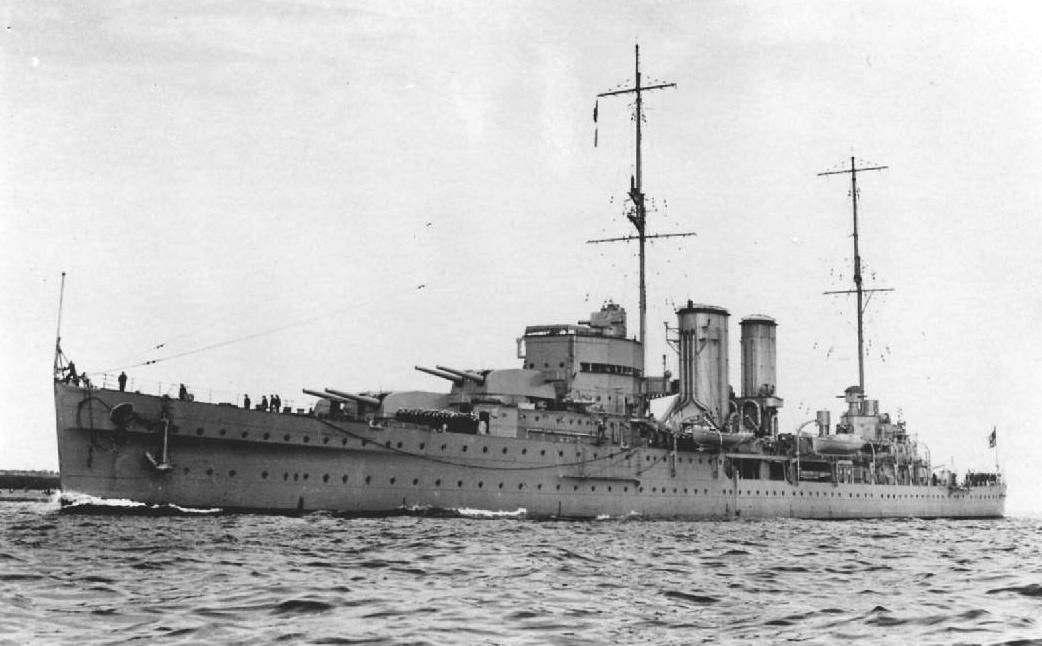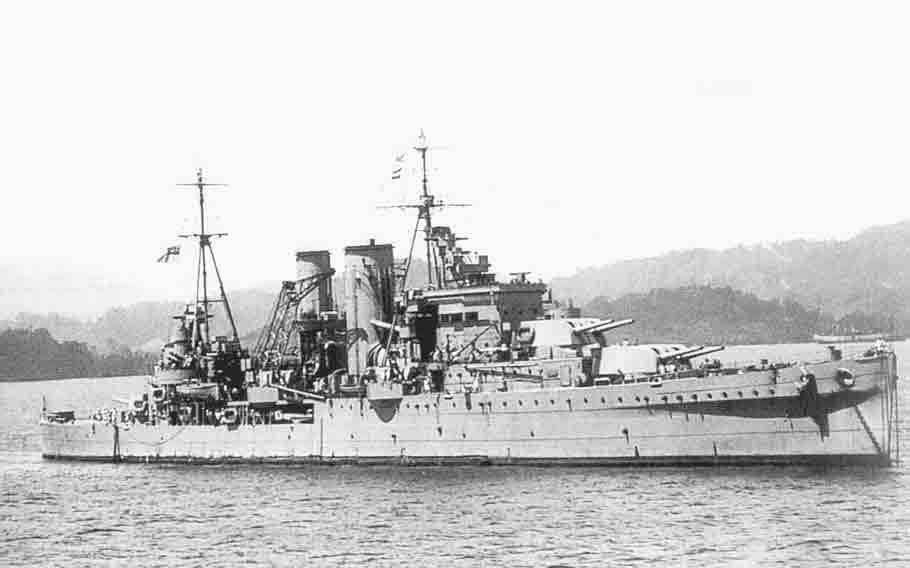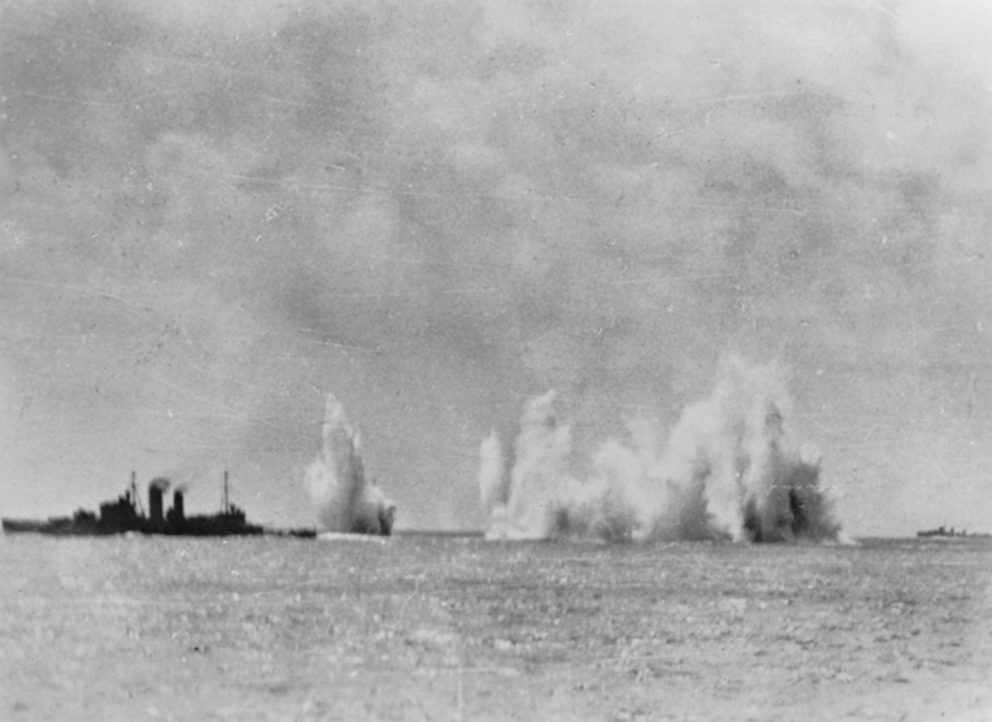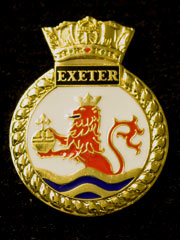

HMS Exeter (68) was a York class heavy cruiser of the Royal Navy that served in World War II. She was laid down on 1 August 1928 at the Devonport Dockyard, Plymouth, Devon. She was launched on 18 July 1929 and completed on 27 July 1931. She fought against the German pocket battleship Graf Spee at the 1939 Battle of the River Plate, suffering extensive damage that caused a long refit. Having been rebuilt, she was sent to the East Indies where she was sunk by the Japanese in 1942.
Exeter was ordered two years after her sister York and therefore her design incorporated improvements in the light of experience with the latter. Her beam was increased by 1-foot (30 cm) to cater for increases in topweight, and the boiler uptakes were trunked backwards from the boiler rooms, allowing for straight funnels removed from the bridge rather than the raked funnels necessary in York to ensure adequate dispersal of the flue gasses. As a result, the masts were stepped straight, and the after funnel was thickened, to aid appearance. As the roof of the 8-inch (203 mm) gun turret had proved to be inadequately strong to accommodate the catapult intended for York, Exeter had a pair of catapults angled out from amidships, with the associated crane stepped to starboard. Consequently, the bridge could be lowered (that of York being tall to give command over the intended aircraft arrangements), and was of a modern, enclosed design that was incorporated into later cruiser designs.
Modifications
In 1932, Exeter had side plating added amidships to the upper deck to enclose her open main deck as far as the after funnel (unlike the County class, the Yorks were not flush-deckers). This provided additional enclosed spaces for accommodation and working. In 1935, the intended multiple Vickers machine guns were finally added, single QF 2-pounder guns having been fitted in lieu. Early war modifications saw the replacement of the single 4-inch (102 mm) guns with modern twin Mark XVI models on the ubiquitous mounting Mark XIX and a single 20 mm Oerlikon gun added to the roof of both 'B' and 'X' turrets. Radar Type 286 air warning was added requiring the pole masts to be replaced by tripods, this primitive metric set had separate transmitting (Tx) and receiving (Rx) aerials, one at each masthead. Radar Type 284 was fitted to the director control tower atop the bridge to provide ranging information and spot fall of shot.
Service
On completion, Exeter joined the 2nd Cruiser Squadron with the Atlantic Fleet, where she served between 1931 and 1935. In 1934 she was assigned to the America and West Indies Station and remained there, with a temporary deployment to the Mediterranean during the Abyssinian crisis of 1935 and 1936, until 1939.
At the outbreak of the Second World War, she formed part of the South American Division with Cumberland. Together with the Leander class light cruisers Ajax and Achilles she engaged the German pocket battleship Admiral Graf Spee in the Battle of the River Plate on 13 December 1939, which culminated in the scuttling of the Admiral Graf Spee several days later. Exeter operated as a division on her own, Achilles and Ajax as the other, in order to split the fire of Graf Spee. Exeter was hit by seven 11-inch shells and several near misses caused significant splinter damage. Sixty-one of her crew were killed and another twenty-three wounded. All three 8 inch turrets were put out of action and her speed was reduced to 18 knots (33 km/h), forcing her to withdraw from battle.
Exeter made for Port Stanley in the Falkland Islands for emergency repairs which took until January 1940, then returned to Devonport without assistance for full repairs between February 1940 and March 1941. On 10 March, 1941, during the repair and refit period, her commanding officer, Captain W.N.T. Beckett MVO DSC died at Saltash Hospital, from complications resulting from surgery related to injuries received earlier in his career. He died the day Exeter was due to be re-commissioned. His replacement was Captain Oliver Loudon Gordon.
On returning to the fleet in 1941 she was engaged on escort duty for Atlantic convoys, including the escort of convoy WS-8B to the Middle East during the Bismarck episode. After this, she went on to the Far East. On the entry of the Empire of Japan into the war in December 1941, Exeter formed part of the ABDACOM naval force intended to defend the Dutch East Indies (Indonesia) from Japanese invasion.
Exeter under attack in the First Battle of the Java Sea.

Fate
On 27 February 1942, Exeter was damaged in the Battle of the Java Sea when she received an 8-inch shell hit to a boiler room and was subsequently ordered to Surabaya for repairs. The destroyer HMS Electra was sunk covering her withdrawal. Two days later, when she attempted to reach the Sunda Strait, she was intercepted by the Japanese heavy cruisers Nachi, Haguro, Myoko and Ashigara and the destroyers Akebono, Ikazuchi, Inazuma, Yamakaze and Kawakaze on the morning of 1 March 1942.
The Second Battle of the Java Sea ensued, now more appropriately called The Battle of Bawean Island, and Exeter was soon badly damaged by gunfire, one hit causing the loss of all power to the ship. Scuttling charges were set and she soon began sinking, initially listing to port only to be hit to starboard by a torpedo from the destroyer Inazuma which sat her back upright and rolled her to starboard before she finally sank about noon. Her escorting destroyers, HMS Encounter and USS Pope were also lost; Pope temporarily escaped the initial melee, only to be sunk by aerial attack a few hours later. About 800 Allied seamen, including the commander of Exeter, Captain Oliver Gordon, were picked up by the Japanese and became prisoners of war.
The wreck was located and positively identified in February 2007. Exeter lies in Indonesian waters, at a depth of about 200 ft (60 m), 90 miles north of Bawean Island - some 60 miles from the sinking position given by her captain.


No comments:
Post a Comment